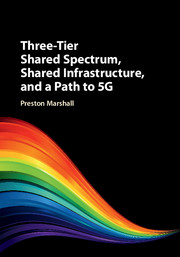Book contents
- Frontmatter
- Contents
- Acknowledgments
- Preface
- Part I Spectrum Sharing Background
- Part II Three-Tier Dynamic Spectrum Models
- Part III Components of a Three-Tier Architecture
- 5 Three-Tier Spectrum Admission Control Systems
- 6 Admission Control Management of Access Point Devices and Their Clients
- 7 Taxonomy of Protection Methods to Be Provided Across and Within Tiers
- Part IV Protection Processes for Incumbents and Peers
- Part V Example Use of Three-Tier Spectrum: Use of the 3.5 GHz CBRS Band in the USA
- Part VI Future Bands, Network Services, Business Models, and Technology
- Part VII Appendices
- Index
- References
6 - Admission Control Management of Access Point Devices and Their Clients
from Part III - Components of a Three-Tier Architecture
Published online by Cambridge University Press: 30 August 2017
- Frontmatter
- Contents
- Acknowledgments
- Preface
- Part I Spectrum Sharing Background
- Part II Three-Tier Dynamic Spectrum Models
- Part III Components of a Three-Tier Architecture
- 5 Three-Tier Spectrum Admission Control Systems
- 6 Admission Control Management of Access Point Devices and Their Clients
- 7 Taxonomy of Protection Methods to Be Provided Across and Within Tiers
- Part IV Protection Processes for Incumbents and Peers
- Part V Example Use of Three-Tier Spectrum: Use of the 3.5 GHz CBRS Band in the USA
- Part VI Future Bands, Network Services, Business Models, and Technology
- Part VII Appendices
- Index
- References
Summary
Introduction
An important consideration in the spectrum management regime is the impact that the spectrum regime has on the flexibility of devices that would utilize it. If the constraints of accommodating the unique constraints of operating within the regime are too great, the benefits of spectrum flexibility will not be realized. In this chapter, we examine the impact of a three-tier regime on the range of devices that populate the secondary ecosystem in a client/Access Point (AP) network mode. In particular, we contrast standalone, independent endpoints, and those that are architecturally dependent on a “superior” node for operation and are therefore subservient to the spectrum decisions of the master (access point) node.
This hierarchal arrangement of access point and client is the fundamental design concept behind most of the current wireless Local Area Networks (LAN) and Wide Area Network (WAN) architectures, such as 2G, 3G, and 4G technologies, such as Long-Term Evolution (LTE), as well as Wireless Fidelity (Wi-Fi). In this chapter, we examine the implications of this architecture on three-tier regimes, and vice versa.
Management of Different Connectivity Models
It might appear that the secondary spectrum regime controls would have to be accessed by all of the devices that operate in a secondary status. In this section, we will examine at what level of the network to apply these requirements at, and therefore the ability to operate devices that are not three-tier aware in the three-tier ecosystem. The question is at what level of the network to apply these spectrum management techniques? The question of what is a controlled device, and what is not, is an important consideration and is not as obvious as it would appear.
We consider two treatments that can be applied:
Endpoints Link with fixed, independent endpoints of operation, either of which could transmit independently, or that have unique interference regions, such as with high gain antennas.
Access Points Links that may have more than one client device, when the clients cannot operate independently of the AP, and have overlapping interference regions, or whose locations would not be fixed, or knowable.
- Type
- Chapter
- Information
- Publisher: Cambridge University PressPrint publication year: 2017



